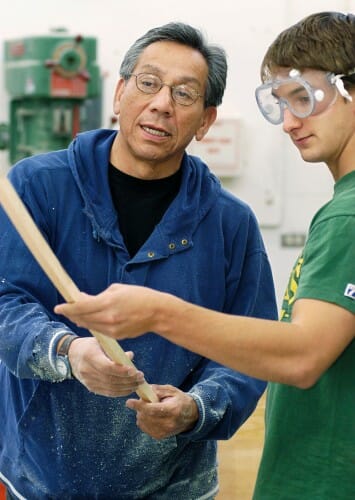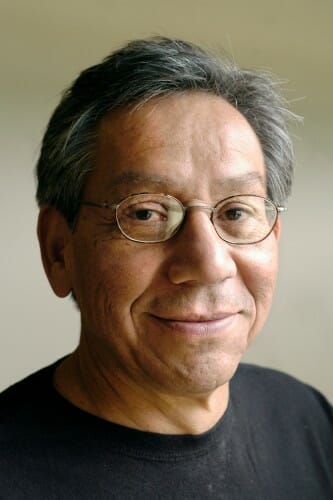UW–La Crosse arts building named after former UW–Madison professor
 UW–La Crosse has dedicated its Center for the Arts to the late Truman Lowe, a UWL alumnus who drew international acclaim during his five-decade career and inspired thousands of aspiring artists as a professor at UW–Madison.
UW–La Crosse has dedicated its Center for the Arts to the late Truman Lowe, a UWL alumnus who drew international acclaim during his five-decade career and inspired thousands of aspiring artists as a professor at UW–Madison.
The Truman T. Lowe Center for the Arts was dedicated Oct. 3, in an event featuring a traditional Ho-Chunk blessing and comments from family and friends.
UW–La Crosse Chancellor Joe Gow says there are many things to celebrate about Lowe’s life and career — particularly the way he advanced Native American culture through his art.
“During his life, Truman Lowe fully embodied the UWL spirit — striving for excellence, honoring his culture and heritage, and leaving the world a better place than he found it,” Gow says. “I’m proud to call Truman Lowe an alumnus of our university. I hope seeing his name on the Center for the Arts will inspire future generations to learn about his legacy and work to create their own.”

Truman Lowe, professor of art and a wood sculptor, teaches a student how to safely use a table saw and offers other woodworking tips during a wood sculpture class in 2004.
Lowe’s family members say they’re grateful the man they knew is being celebrated for his outstanding career and transformative impact on so many people.
“On a personal level, he was an incredibly empathetic person and always knew what to say to support someone at a pivotal moment in their life,” says Tonia Lowe, Truman’s daughter. “Professionally, he was part of a second wave of Native artists that really helped change people’s perceptions of what Native art could be. This feels like recognition for all the work he did to open people’s minds and pave the way for the next generation.”
As a professor of art at UW–Madison, Lowe was an inspiration for aspiring artists.
After earning his bachelor’s degree in art education in 1969, Lowe had a short stint as an art teacher at Valders High School, about 45 miles north of Milwaukee.
He left to attend UW–Madison, where he earned a Master of Fine Arts degree in 1973 and accepted a faculty position in 1975. He spent 30 years in the university’s Art Department, serving as chair from 1992 to 1995.
He was celebrated for his sculpture and large art installations, which were often constructed from natural materials and explored Ho-Chunk culture and history through a contemporary lens.
His art was exhibited worldwide, including in Europe, Africa, South America and major galleries across the United States. In 1998, one of his sculptures, “Bird Effigy,” was selected for a yearlong exhibit at the White House.

Truman Lowe
Lowe was admired not just for his creations, but also for his keen artistic eye and knowledge of the history of art.
In 2000, those qualifications helped him become the curator of contemporary art for the Smithsonian National Museum of the American Indian — a position he held until 2008.
Jo Ortel, a professor at Beloit University, met Lowe in the late 1990s, when she invited him to speak to an art history class she was teaching at UW–Madison.
The pair developed a friendship, and over the years, Ortel became an expert on Lowe’s life and career.
To her, the quality of Lowe’s artwork is matched only by the impact he made on thousands of students and art enthusiasts — not just as an artist, but also as an educator and curator.
“Truman’s legacy lives on in the thousands of students from all different backgrounds whom he taught,” Ortel says, noting that Lowe was always mindful of significant milestones for Native America. “Surely, UWL’s decision to name its Center for the Arts in honor of a Wisconsin Ho-Chunk artist is right up there. He’s wearing a big smile somewhere.”
Lowe’s art often explored the natural world and its significance to Native American history and culture.
Ryan John Crain Sr., a demonstration grant administrator with the Ho-Chunk Nation, said Lowe is an inspiration not only to people who knew him, but to everyone who has seen his example.
“A life of service has created a domino effect that will inspire indigenous youth for years to come,” Crain said. “Truman’s name being placed on the front of this building is historic. Representation matters. Let me say that again: Representation matters.”
The Truman T. Lowe Center for the Arts, as it will soon be called, opened as the Fine Arts Building in the fall of 1974. It currently houses the School of Visual & Performing Arts, which includes the Art, Theatre and Music departments.
Tags: arts, Native Nations




